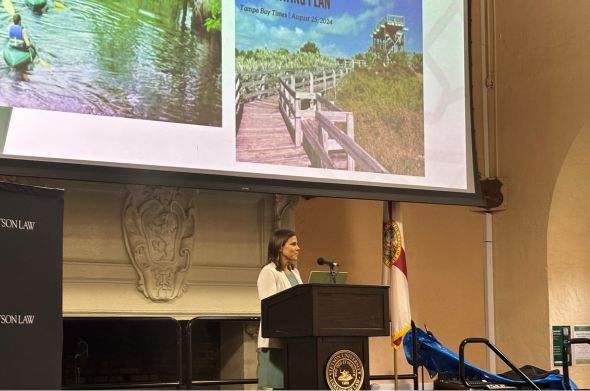How Grassroots Advocacy Helped Stop Plan to Develop State Parks

As she began the first Foreman Biodiversity Lecture of the semester, speaker Casey Darling Kniffin asked the audience to picture their favorite Florida State Park.
Most Floridians, she said, have a favorite, where they go to experience open space and natural wonders. Kniffin’s is Jonathan Dickinson State Park just north of Jupiter on Florida’s Atlantic coast.
Florida’s 175 state parks are award-winning, critical wildlife habitat, and the product of decades of investment supported by Florida’s leadership and citizens alike.
“They’re also deeply personal,” Kniffin said. “These are the places that people go to swim, hike, paddle, fish.”
That’s why, when a plan to build golf courses, pickleball courts, lodging, and other facilities in nine state parks, Kniffin, who is conservation policy director for the nonprofit Florida Wildlife Foundation, had to act.
A threat to public lands
In August of 2024 rumors began to swirl about a plan to develop state parks. Kniffin knew her organization needed to take to social media to lead the fight against such a proposal but had difficulty tracking down hard proof. The idea of paving over Florida’s beloved natural lands seemed outlandish.
“I think that we all just assumed these places that had decades of investment going into them and knowing how cherished they are to the people of Florida, I really don’t think anyone thought they’d threaten them at this magnitude,” she said. “And then the Great Outdoors Initiative suggested otherwise.”
On August 24, a Department of Environmental Protection employee leaked a memo revealing details of the plan to the public. It summarized the changes to nine state parks: Anastasia, Topsail Hill, Camp Helen, Grayton Beach, Honeymoon Island, Hillsborough River, Dr. Von Mizzell, Oleta, and Kniffin’s beloved Jonathan Dickinson. It included proposed golf courses, pickleball courts, and non-rustic accommodations that would have involved destruction of native landscapes and critical wildlife habitats.
“That land belonged to the people of Florida, and suddenly it felt like what Floridians wanted was not even taken into consideration,” she said.
A rapid response
The state officially released details of the plan on August 19 – as well as meetings scheduled for the following week in which the public could voice their concerns, assuming their schedules allowed for it.
Kniffin and her colleagues sprang into action. They took to social media to encourage Floridians to attend meetings, send emails, and speak at events.
“Our goal was to share information fast,” she said. “It was a full court press.”
The people really did respond. Social media posts reached over three million people. Hundreds of people showed up at rallies. The governor’s office received more than 250,000 emails and countless phone calls opposing the plan. People made art, encouraged others to speak out, and wrote letters. Media outlets, especially The Tampa Bay Times, covered it extensively.
“Finally, after eight days, it worked,” she said.
The state tabled the proposal on August 28, but another battle was just beginning.
Fighting for state protections
A coalition of groups then had to rally for a state law preventing a plan to develop state parks from ever seeing the light of day. Lawmakers in the state house and state senate eventually introduced such legislation.
“Legislators felt this groundswell, and they responded,” she said. “It was really proof that our elected officials do listen when enough people speak out together.”
But getting the bill passed in the State House and State Senate felt like an uphill battle. It was subject to weakening by lawmakers. It stalled in committee for weeks in the middle of the legislative session.
It finally passed and, after another wave of advocacy, signed into law by the governor in May of 2025.
A lesson for aspiring advocates
Kniffin told her audience, which consisted largely of Stetson Law students, that she hopes this success story inspires environmental advocates to continue the fight to protect Florida’s natural resources for generations to come.
“So how do we keep this going? I think it’s by remembering that each of us has a role to play,” Kniffin said. “It is important to remember that you’re part of something bigger and what you do really matters.”
Everyone has something to contribute to the cause, she added. Some are natural advocates; or apt to call, write, and meet with legislators; or artists and storytellers whose visuals, videos, art, podcasts, and other content will serve as an inspiring call to action for Floridians across all walks of life.
“The call to defend our state parks came from people of all backgrounds,” Kniffin said. “Students, scientists, business owners, lawyers, grandparents, artists, and what united us was a simple truth: that we love Florida State Parks; we love Florida’s wild lands writ large.”
Learn more about Florida Wildlife Federation’s campaign against proposed developments in Florida State Parks.
Post date: Oct. 7
Media contact: Kate Bradshaw
[email protected] | 727-430-1580